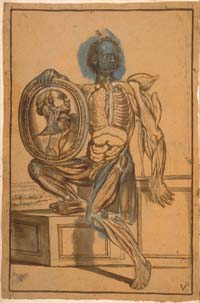|
|
|
These drawings are the work of one of the most prominent
artists of the Roman High Baroque, and were prepared from dissections made at
the Santo Spirito Hospital about 1618. Typically for the period, the figures are
vividly posed within landscapes adorned with classical ruins, some holding what
appear to be framed mirrors in which are reflected ancillary figures. The
drawings are highly finished in brown ink and black chalk, washed with blue,
sepia and grey. Certain structures, for example, the nerves are highlighted with
white paint.
Click on thumbnail for larger image.
|
|

Tabulę
anatomicę a Petro Berrettino delineate, ... Romę, 1741.Table 5.
[Z.1.7] |
The drawings were used as the basis of engravings, but
these were not published until 1741, some one hundred and twenty years later.
Hunter was presented with this volume by the distinguished
diplomat Sir William Hamilton in 1772.
In table five, the thorax and the
abdomen have been opened up and the legs and arms have been dissected.
|